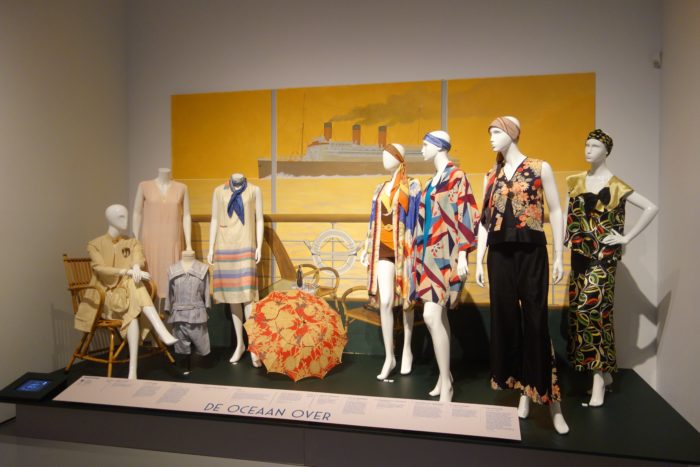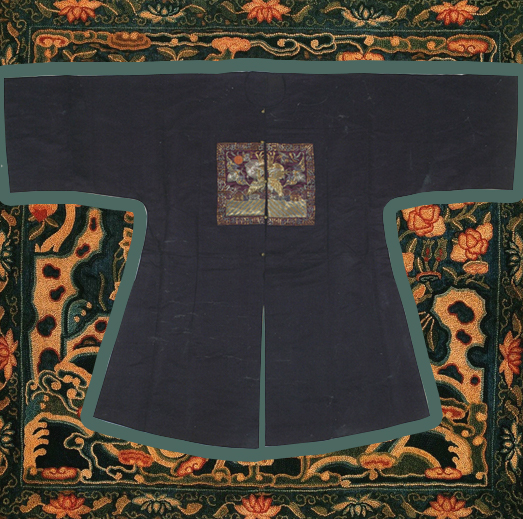During my Christmas break at home in the Netherlands, I visited the TextielMuseum, located in a former textile factory in the city of Tilburg, in order to view their recently opened exhibition, JAZZ AGE | Fashion & Photographs. Organised by the Fashion and Textile Museum in London, this exhibition aims to show the variety of dress available to the modern woman and the completely new way of dressing that symbolised her new-found freedom and active lifestyle in the period after the First World War. The exhibition showcases more than 150 haute couture and ready-to-wear garments dating from 1919 to 1929 in different settings such as ‘In the Boudoir,’ ‘Tennis Match,’ and ‘Chinatown After Dark.’ As might be expected from a dress and textiles enthusiast, I was swooning in front of the quintessential fringed and beaded drop-waist flapper dresses and sumptuously embroidered velvet evening capes one would have worn for a night out.
The current exhibition at the TextielMuseum seems to have a slightly different design than the exhibition that was staged in London (see the excellent review written last year by former MA student Sophie Assouad). Instead of writing another review, I have chosen to focus on a specific display in this exhibition that sparked my interest because it gave me a fresh perspective on this particular period in fashion history.
Conjuring the scene of a steamboat’s deck, ‘On the Ocean Liner’ takes the visitor beyond the notion of the 1920s as a decade of glamourous nightlife and the familiar flapper dress. It does so by showcasing daytime and leisurewear suitable for the journey aboard an ocean liner on its way to a sunny destination.
Lounging in a rotan chair to the left is a mannequin wearing a simple, cream-coloured tunic dress with a jacket in the same colour, both dating from c. 1924–25. While the dress has been made from silk, the jacket’s material, interestingly, is ‘rayon’, a man-made fibre made from chemically treated cellulose. Generally known as ‘artificial silk,’ this material was first developed in the late nineteenth century but only became widely available from the 1920s onwards. The fibre was officially renamed rayon in 1924 through an industry-sponsored contest with the aim to counter the frequent associations with artificiality or inferiority to natural silk. Rayon grew in popularity as it provided women from all backgrounds the ability to wear certain garments that were previously reserved only for those who could afford to buy silk.
My favourite ensemble in this arrangement is a simple, but chic, striped dress with pockets and pleats made from silk that dates from c. 1922–23. This dress combines comfort and freedom of movement with elegance and is reminiscent of the silhouette and style of clothing designed by Coco Chanel.

Moving to the right, the eye meets a group of mannequins wearing boldly-coloured, Art Deco-patterned beach pyjamas and loose, kimono-inspired dresses worn over cotton swimsuits. This group hints at a day spent swimming – or perhaps lounging and sunbathing at the pool, cultivating the tanned skin that was promoted by Chanel and became popular during this decade.

‘On the Ocean Liner’ addresses how swimming became popular among women in the second half of the decade when American competition swimmer Gertrude Ederle (1905 –2003) became the first woman to swim across the Channel in 1926. A cotton swimsuit in a herringbone pattern with a subtly integrated skirt is used to illustrate the active lifestyle and freedom of movement of modern women during the 1920s. I particularly enjoyed the attention given to materials and construction details, such as the contrasting cuffs of a cotton swimsuit that were not only a chic addition, but also helped to keep it in shape when immersed in water.
Finally, by focusing on 1920s women’s fashion from the angle of sports, leisure, and travel, ‘On the Ocean Liner’ felt like an inspiring warm up to the Victoria & Albert Museum’s upcoming exhibition Ocean Liners: Speed & Style, which will explore the golden age of ocean travel around the world.
By Nelleke Honcoop
—
JAZZ AGE | Fashion & Photographs is on display at the TextielMuseum, Tilburg, The Netherlands, until 27 May 2018. See: http://www.textielmuseum.nl/en/
Ocean Liners: Speed & Style will be on display at the Victoria and Albert Museum from 3 February – 10 June 2018. See: https://www.vam.ac.uk/exhibitions/ocean-liners-speed-style





